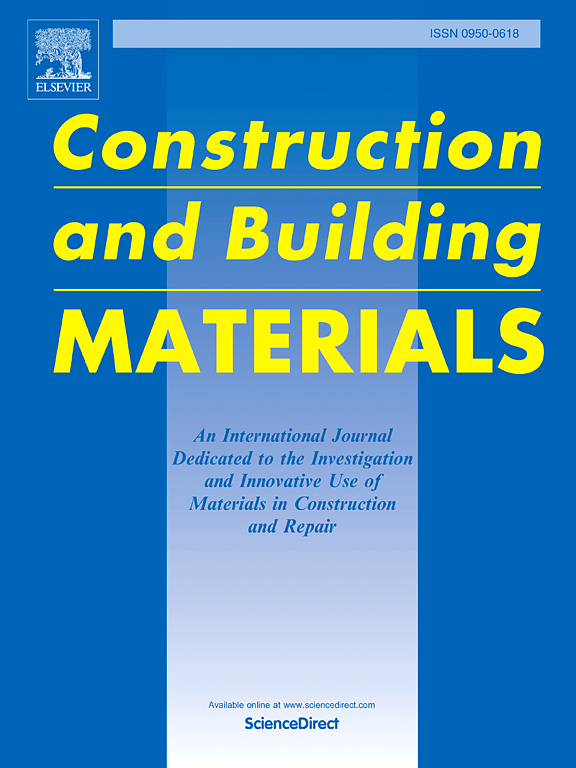通过多次应力蠕变恢复试验分析沥青的非线性粘弹性响应
IF 7.4
1区 工程技术
Q1 CONSTRUCTION & BUILDING TECHNOLOGY
引用次数: 0
摘要
多重应力蠕变恢复(MSCR)试验获得沥青的力学响应对表征其高温性能具有重要意义。然而,现有的研究难以准确确定区分沥青在不同温度下的线性粘弹性阶段和非线性粘弹性阶段的临界应力值。为了解决这一问题,本研究对五种沥青在不同温度下进行了MSCR试验,并采用Schapery的非线性粘弹性理论分析了每种沥青在不同温度和应力水平下的力学行为。最后,根据计算得到的非线性粘弹性参数,区分了沥青在线性粘弹性、非线性粘弹性和损伤阶段的临界应力。结果表明:通过不同应力下的恢复蠕变柔度Jr与参考应力下的恢复蠕变柔度的重叠,可以初步确定由线性粘弹性向非线性粘弹性过渡的临界应力;当计算的非线性粘弹性参数g2开始减小时,对应的应力表示线性粘弹性阶段与非线性粘弹性阶段之间的临界应力。g2随应力的增大而减小,且与应力比密切相关。非线性粘弹性参数g1随应力水平的增加呈增大趋势,当其达到最大值时,表明沥青即将进入损伤状态。沥青线性粘弹阶段和非线性粘弹阶段的临界应力σL-NL与温度呈指数函数关系,可用于预测沥青在不同温度下的粘弹性能。本文章由计算机程序翻译,如有差异,请以英文原文为准。
Analysis of nonlinear viscoelastic response of asphalt through multiple stress creep recovery test
The mechanical response of asphalt obtained from the multiple stress creep recovery (MSCR) test is of great significance to characterize its high-temperature performance. However, existing studies struggle to accurately determine the critical stress value for differentiating the linear viscoelastic and nonlinear viscoelastic stages of asphalt at different temperatures. To address this issue, this study conducts the MSCR test on five types of asphalt at different temperatures and employs the Schapery's nonlinear viscoelastic theory to analyze the mechanical behavior of each type of asphalt under varying temperatures and stress levels. Eventually, the critical stress at the linear viscoelastic, nonlinear viscoelastic, and damage stages of asphalt is distinguished according to the calculated nonlinear viscoelastic parameters. The results show that the critical stress for the transition from linear to nonlinear viscoelasticity can be initially identified by the overlap of the recovery creep compliance Jr under different stresses with that at the reference stress. When the calculated nonlinear viscoelastic parameter g2 starts to decrease, the corresponding stress represents the critical stress between the linear and nonlinear viscoelastic stages. Furthermore, g2 decreases with increasing stress and is closely related to the stress ratio. The nonlinear viscoelastic parameter g1 tends to increase with the stress level, and when it reaches its maximum value, it indicates that the asphalt is about to enter the damage state. The critical stress σL-NL between the linear and nonlinear viscoelastic stages of asphalt shows an exponential function relationship with temperature, which can be used to predict the viscoelastic properties of asphalt at different temperatures.
求助全文
通过发布文献求助,成功后即可免费获取论文全文。
去求助
来源期刊

Construction and Building Materials
工程技术-材料科学:综合
CiteScore
13.80
自引率
21.60%
发文量
3632
审稿时长
82 days
期刊介绍:
Construction and Building Materials offers an international platform for sharing innovative and original research and development in the realm of construction and building materials, along with their practical applications in new projects and repair practices. The journal publishes a diverse array of pioneering research and application papers, detailing laboratory investigations and, to a limited extent, numerical analyses or reports on full-scale projects. Multi-part papers are discouraged.
Additionally, Construction and Building Materials features comprehensive case studies and insightful review articles that contribute to new insights in the field. Our focus is on papers related to construction materials, excluding those on structural engineering, geotechnics, and unbound highway layers. Covered materials and technologies encompass cement, concrete reinforcement, bricks and mortars, additives, corrosion technology, ceramics, timber, steel, polymers, glass fibers, recycled materials, bamboo, rammed earth, non-conventional building materials, bituminous materials, and applications in railway materials.
 求助内容:
求助内容: 应助结果提醒方式:
应助结果提醒方式:


